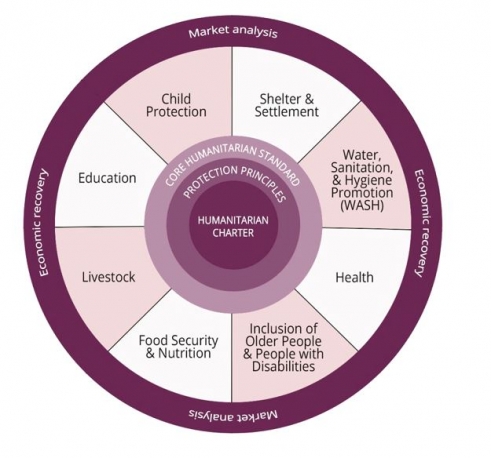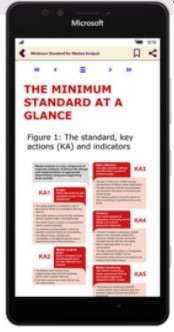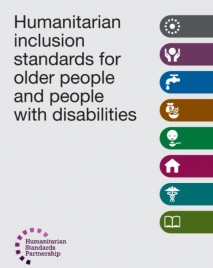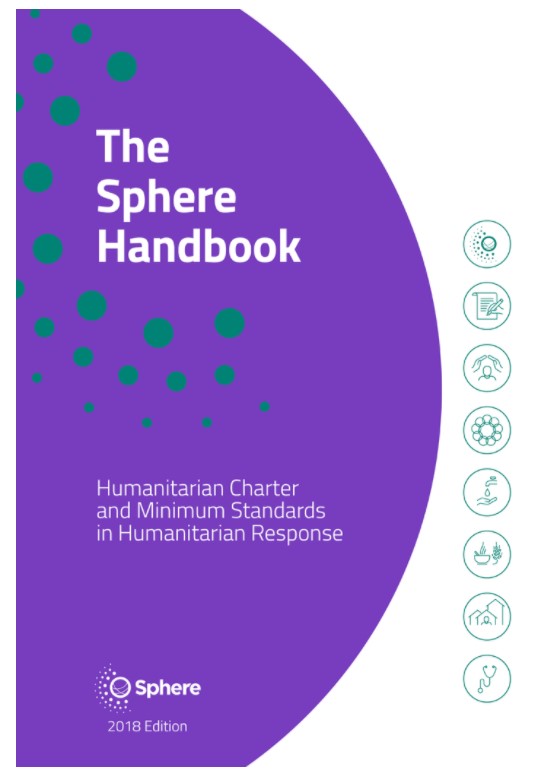As a member of the Humanitarian Standards Partnership, HelpAge partners with CBM Global to increase awareness of the importance of inclusive practices for older people and people with disabilities across the humanitarian sector.
This is achieved through the development of humanitarian standards, statements which describe the actions needed so that people caught up in crises are able to exercise their rights, specifically to receive protection and assistance and to live in dignity.
Developed by practitioners of different backgrounds based on available evidence and their own experiences, they reflect what the humanitarian community believes are the current best practices. They are revised regularly to incorporate developments and new learning across the sector.
Humanitarian standards are a useful resource for anyone involved in providing assistance and protection. They can be used to prepare before crises strike, identify needs, plan a humanitarian response or evaluate it. Affected communities can refer to them to understand their own rights and call for better assistance.
Humanitarians agencies and workers make a commitment to quality when they apply standards in their work. They also make themselves accountable to the populations they serve. Learn more.
What is the Humanitarian Standards Partnership?
The Humanitarian Standards Partnership (HSP) is a coalition of initiatives, all of which share a similar approach. They see humanitarian standards as an expression of human rights developed via inclusive consultation processes with a wide range of practitioners, and which create a broad consensus on best practices.
The HSP aims to harmonise different sets of humanitarian standards and promote their implementation. It also supports practitioners looking to learn more with training opportunities, outreach and advocacy activities. Learn more.
The HSP currently consists of seven sets of standards:
- The Sphere Handbook – By Sphere
- Minimum Standards for Market Analysis – By the Cash Learning Partnership
- Child Protection Minimum Standards – By the Child Protection Working Group
- Minimum Standards for Education – By the Inter-Agency Network for Education in Emergencies (INEE)
- Livestock Emergency Guidelines and Standards – By LEGS
- Minimum Economic Recovery Standards – By the SEEP Network
- Humanitarian inclusion standards for older people and people with disabilities – By the Age and Disability Capacity Programme
Ethical and legal bases
All HSP members’ standards share a common framework of principles and foundations.
The Humanitarian Charter Drafted by practitioners in 1997, the charter expresses a commitment to humanitarian action and provides an ethical and legal framework for it. Learn more.
The Protection Principles Four principles remind practitioners that humanitarian assistance should protect people from violence, avoid causing harm, ensure access to impartial assistance and support people’s recovery from abuse. Learn more.
The Core Humanitarian Standard This voluntary code sets out the essential elements of principled, accountable and quality humanitarian action, articulated in a set of nine commitments. Learn more.
Areas and topics covered by the partner standards
HSP members’ initiatives provide guidance on different but complementary areas of humanitarian response.

Accessing the HSP standards
Users can read the standards in a variety of formats. They are available in hard copy and PDF versions, and via a mobile app and an interactive digital platform.

HSP mobile app: Standards at your fingertips
The HSPapp allows practitioners to consult the full set of standards on their smartphones, wherever they are. Developed especially for fieldworkers on the move, it works even without an internet connection.
Users can simply browse the content or search by keyword. The app can be downloaded free of charge from Apple, Google and Microsoft.
Interactive handbook: Humanitarian inclusion standards for older people and people with disabilities
The Humanitarian inclusion standards for older people and people with disabilities are designed to help address the gap in understanding the needs, capacities and rights of older people and people with disabilities, and promote their inclusion in humanitarian action.
They are designed both to strengthen the accountability of humanitarian actors to older people and people with disabilities, and to support the participation of older people and people with disabilities in humanitarian action.
The standards can be used as guidance for programming, and as a resource for training and advocacy.
Interactive handbook: Browse online and share your comments
Some HSP members’ initiatives are also available via an online platform called Interactive Handbook. Users can browse various sets of standards in different languages, search for specific keywords and resources, and jump from one chapter to another. The platform also provides quick and easy access to other learning resources and references.
Starting in 2020, Interactive Handbook users can share their experiences of working with standards. They can upload new evidence and case studies, and dis¬cuss issues with other users in an online forum. These developments mean that over time the handbook will become a tool for collaboration and a repository of ongoing changes in practice and knowledge.
The HSP case studies
HSP has produced a series of case studies that illustrate how standards are applied in practice. Developed on the basis of reports and interviews with humanitarian practitioners, they can be used for self-learning, training and awareness raising.
Learn more about the HSP here or email hsp@spherestandards.org.


